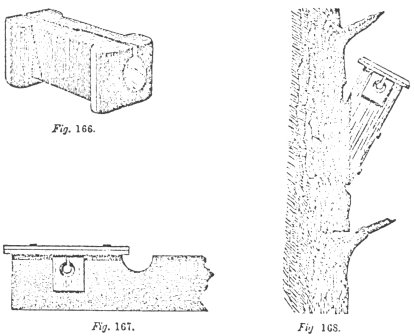Electricity and the Electric Telegraph
Reprinted from "INSULATORS - Crown Jewels of the Wire", February 1971, page 12
These two pages were reproduced from Electricity & the Electric Telegraph
by George B. Prescott, published by D Appleton & Co. in 1877.
This interesting bit of information was sent in by Frank & Marjorie
Jones, Box 73, Cottontown, Tennessee 37048.
The lines running through the sparsely settled and forest covered regions of
the south-western States are frequently fitted with an insulator known as the
"square glass," which has been in use for this class of lines ever
since 1846. Although much less perfect in its insulating qualities than many
others, it is practically indispensable under the peculiar circumstances which
attend the maintenance of lines in the portions of the country to which we have
referred.
Fig 166 is a perspective drawing of the square glass insulator, which is a
little more than three inches in length A longitudinal aperture passes through
the glass, about half an inch in diameter in the center, expanding to an inch at
each end. The wire is dropped into this through a narrow longitudinal slot on the upper
side, which has an angle in it, as shown in the figure, in order to prevent the
line wire from being drawn out by an upward strain. The sides and bottom of the
glass are provided with projections which hold it in its place when it is
inserted in a cross-arm, as shown in fig 167. A notch of suitable size and shape
is cut in the upper side of the arm, the insulator and wire are put in their
places, and a piece of board is then nailed over the top to serve as a roof.
Fig. 168 shows the manner in which this insulator is fitted to a bracket, for
attachment to the trunk of a living tree. The advantage derived from the use of this insulator in a forest covered
territory is, that if a tree falls across the line the wire will not be broken
[(new page w/title) CONSTRUCTION OF LINES IS THE UNITED STATES.
305]
but will be carried down with the tree, and the strain will merely cause the
slack to be taken up for some distance on each side. The wire passes freely
through the insulators, not being fastened to them in any manner, and as it
seldom actually touches the ground the communication is rarely interrupted. 
The
degree of insulation obtained is considerably higher than would be supposed at
first sight, for the reason that the surface of contact between the wire and the
glass is much less than in the ordinary forms, and this serves in a great
measure to compensate for its disadvantages in other respects. With any of the ordinary insulators
it would be quite impossible to keep a line working in some parts of the country
for any considerable portion of time, owing to the numerous interruptions arising from
falling trees. The square glass insulator also allows the trees to which the line is attached, as in fig 168, to sway in, the wind without
danger of breaking the wire.
| 